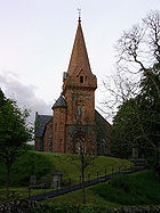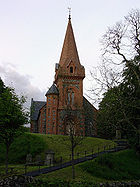
Tweedsmuir
Encyclopedia

Civil parishes in Scotland
In Scotland, parishes, as units of local government, were abolished by the Local Government Act 1929. The geographical area is sometimes still referred to, however, for statistical purposes....
situated 8 miles (12.9 km) from the source of the River Tweed
River Tweed
The River Tweed, or Tweed Water, is long and flows primarily through the Borders region of Great Britain. It rises on Tweedsmuir at Tweed's Well near where the Clyde, draining northwest, and the Annan draining south also rise. "Annan, Tweed and Clyde rise oot the ae hillside" as the Border saying...
, in the Scottish Borders
Scottish Borders
The Scottish Borders is one of 32 local government council areas of Scotland. It is bordered by Dumfries and Galloway in the west, South Lanarkshire and West Lothian in the north west, City of Edinburgh, East Lothian, Midlothian to the north; and the non-metropolitan counties of Northumberland...
area of Scotland
Scotland
Scotland is a country that is part of the United Kingdom. Occupying the northern third of the island of Great Britain, it shares a border with England to the south and is bounded by the North Sea to the east, the Atlantic Ocean to the north and west, and the North Channel and Irish Sea to the...
.
The village is set in the valley, with rolling hills and burns on both sides, covering some fifty square miles. It incorporates settlements at Hearthstane, Cockiland, Menzion
Menzion
Menzion, sometimes Minzion is a small settlement in southern Scotland near Tweedsmuir in the Scottish Borders, in the valley of the River Tweed.-Topography:...
and Oliver
Oliver Castle
Oliver Castle was a small tower house, located in the upper Tweed Valley in the Scottish Borders, within the bounds of the village of Tweedsmuir. The castle was originally part of the line of peel towers along the Tweed Valley. It was replaced in the seventeenth century by a house on the same site,...
. Oliver Castle was one of the strongholds, and later country estates, of the Tweedie family, and there are notable gravestones in the parish churchyard.
It is home to the Crook Inn
Crook Inn
The Crook Inn is an inn in the Scottish Borders, near the village of Tweedsmuir on the A701 road between Broughton and Moffat. It is one of many claimants to be the oldest inn in Scotland. Robert Burns wrote "Willie Wastle's Wife" there. In the early 20th century a halt was built on the Talla...
on the A701
A701 road
-Route:The A701 leaves Dumfries and travels north to meet the A74 at Beattock. It thens joins the A74 for a short spell before branching off to the north-east towards Moffat and ultimately Edinburgh....
, one of many claimants to be the oldest inn in Scotland, and where Robert Burns
Robert Burns
Robert Burns was a Scottish poet and a lyricist. He is widely regarded as the national poet of Scotland, and is celebrated worldwide...
wrote "Willie Wastle's Wife". The Talla Reservoir
Talla Reservoir
Talla Reservoir, located a mile from Tweedsmuir, Scottish Borders, Scotland, is an earth-work dam fed by Talla Water. The reservoir is supplemented by water from the nearby Fruid Reservoir...
and Fruid Reservoir are nearby. In 1894 the Edinburgh and District Water Trustees decided to use Talla as the new source of water for Edinburgh. The surface and the gradient of the main road were unsuitable for carting the quantities of material that would be needed for the new reservoir, so the Talla Railway
Talla Railway
The Talla Railway was a reservoir construction railway in Scotland active from 1897 to 1910. Located in the Scottish Borders, its most substantial engineering feature was the Tweed Viaduct, a 100 foot girder bridge built to carry the railway and water pipeline across the River Tweed at...
was built from Broughton to Talla. While work on the railway and the reservoir was in progress, a large number of workmen lived in Tweedsmuir parish, dramatically increasing the population. The valve-closing ceremony was held at Talla on 20 May 1905, and on 28 September, when the reservoir was about two-fifths full, there was an inaugural ceremony. The large company was brought from Edinburgh in two special trains, which were hauled for the last stage of the journey, from Broughton Station, by small service engines on the Talla railway.

